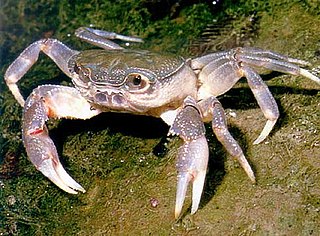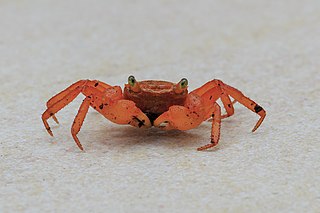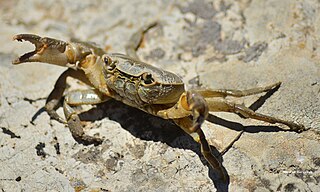
Potamidae is a family of freshwater crabs. It includes more than 650 species and nearly 100 genera, which are placed into two subfamilies: Potaminae and Potamiscinae.

Potamonautidae is a family of freshwater crabs endemic to Africa, including the islands of Madagascar, the Seychelles, Zanzibar, Mafia, Pemba, Bioko, São Tomé, Príncipe and Sherbro Island. It comprises 18 extant genera and 138 extant species. Fossil remains dating from the Late Miocene period have been attributed to the family Potamonautidae.

Geosesarma is genus of small freshwater or terrestrial crabs, typically less than 10 mm (0.4 in) across the carapace. They live and reproduce on land with the larval stages inside the egg. They are found from India, through Southeast Asia, to the Solomon Islands and Hawaii.
Tiwaripotamon vietnamicum is a species of crab. Originally described as a species of Geothelphusa, it is now treated as part of the genus Tiwaripotamon, although it has also been suggested as a member of Hainanpotamon. It is only known from a single locality in Cúc Phương National Park, Ninh Bình Province, Vietnam.

Potamon fluviatile is a freshwater crab found in or near wooded streams, rivers and lakes in Southern Europe. It is an omnivore with broad ecological tolerances, and adults typically reach 50 mm (2 in) in size during their 10–12 year lifespan. They inhabit burrows and are aggressive, apparently outcompeting native crayfish.

Potamon is a genus of freshwater or semiterrestrial crabs mainly found from Southern Europe through the Middle East, and as far east as north-western India. The only exception is the North African P. algeriense, which also is the only potamid of mainland Africa. Twenty species are currently recognised. These crabs are omnivores that have a broad ecological tolerance. The adult Potaman reach up to 50 mm in size during their 10-12 year life span.
Johora singaporensis, the Singapore stream crab or Singapore freshwater crab, is a critically endangered species of freshwater crab endemic to Singapore. It grows to a size of 30 millimetres (1.2 in) wide.

Johora is a genus of freshwater crabs found in the Malay Peninsula and surrounding islands. It includes the following species:

Potamon algeriense is a freshwater crab found in North Africa.
Villalobosius is a genus of crabs in the family Pseudothelphusidae, containing a single species, Villalobosius lopezformenti. It lives in the northern part of the state of Oaxaca, Mexico, on the Isthmus of Tehuantepec, and is adapted to a troglobitic lifestyle.
Cyrtocarcinus truncatus is a species of crab in the family Xanthidae that lives in the waters around Hawaii. It was described in 1906 by Mary J. Rathbun as Harrovia truncata, based on a single immature male specimen caught near Kauai. Masatsune Takeda transferred the species to his new genus Glyptocarcinus in 1979, and Peter Ng and Diana Chia erected a new genus, Cyrtocarcinus, for this species alone, in 1994.
Hainanpotamon is a genus of freshwater crabs, containing the following species:

A number of lineages of crabs have evolved to live predominantly on land. Examples of terrestrial crabs are found in the families Gecarcinidae and Gecarcinucidae, as well as in selected genera from other families, such as Sesarma, although the term "land crab" is often used to mean solely the family Gecarcinidae.

Insulamon palawanense, or the Palawan purple crab is a species of freshwater crab from the Philippines described in 2012. They are 2.5–5.3 centimetres (1.0–2.1 in) wide and are a striking purple colour.
Laevimon is a genus of freshwater crabs, found in Vietnam. Data are deficient concerning their IUCN Red List of Threatened Species status.

Nanhaipotamon is a genus of freshwater crabs, in the subfamily Potamiscinae, found in southern China and Taiwan. As of 2018, 18 species have been described. The genus is named after the South China Sea, for it occurs mostly in coastal areas. The genus was first described by R. Bott in 1968 as Isolapotamon (Nanhaipotamon), i.e., a subgenus of Isolapotamon.

Nanhaipotamon hongkongense is a species of freshwater crab of the genus Nanhaipotamon, known to occur in Hong Kong and adjacent areas in Shenzhen and Dongguan, Mainland China.
Parveen F. Absar is a wildlife biologist from India. In 2017, she was credited with the discovery of a species of freshwater crab called Teretamon absarum, of the genus Teretamon and species speleaum.

Limnopilos naiyanetri, commonly referred to as the Thai micro crab or pill-box crab, is a freshwater hymenosomatid crab endemic to Thailand. Its presence has only been confirmed in the Tha Chin River. The species was described in 1991 and represents the type species of Limnopilos. The Thai micro crab was first introduced to the aquarium hobby in 2008 when it was imported to Germany by the tropical fish importer Aquarium Glaser GmbH, and has slowly grown in popularity with aquarium hobbyists. It remains a relatively rare species on the market and detailed information on the husbandry of this species is scarce.

Sesarmops is a genus of crabs in the family Sesarmidae. Its members are distributed through the Indo-West-Pacific oceanic region. They live in freshwater forest streams near the coast, and in mangroves.










